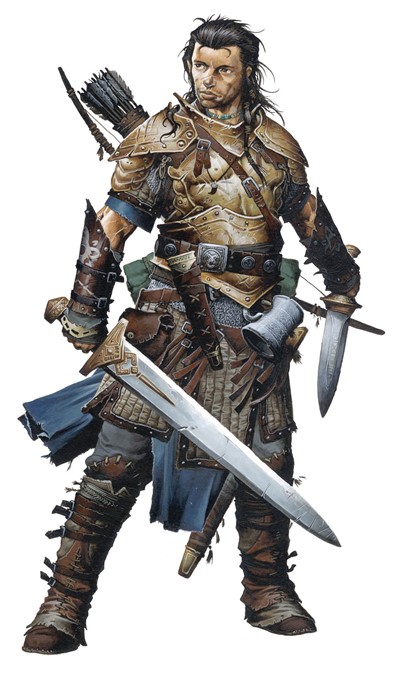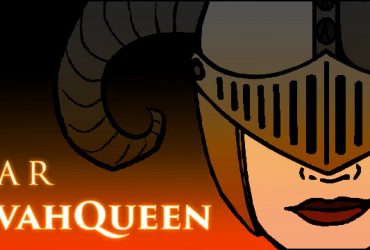For the last two installments of Burst of Insight, I’ve been talking about rebuilding the fighter class. This week I give you a ready to playtest version of the class. Now, my goal was not to reinvent the whole wheel. Much of the text you see here is right from the core rules. Even with the new and altered abilities, I did my best to conform to the existing text of other abilities.
This version of the fighter has a number of small increases that may produce a much more powerful character. Ideally, I don’t want to tip the power too much and I’m hoping with only small adjustments all dependant on a resource management feature we hit the right balance. All in all, I think the changes offer some interesting options for players without breaking the game. Yes, this fighter is a bit more potent but only playtesting at the table will tell if it breaks our game.

Fighter (revised)
Some take up arms for glory, wealth, or revenge. Others do battle to prove themselves, to protect others, or because they know nothing else. Still, others learn the ways of weaponcraft to hone their bodies in battle and prove their mettle in the forge of war. Lords of the battlefield, fighters are a disparate lot, training with many weapons or just one, perfecting the uses of armor, learning the fighting techniques of exotic masters, and studying the art of combat, all to shape themselves into living weapons. Far more than mere thugs, these skilled warriors reveal the true deadliness of their weapons, turning hunks of metal into arms capable of taming kingdoms, slaughtering monsters, and rousing the hearts of armies. Soldiers, knights, hunters, and artists of war, fighters are unparalleled champions and woe to those who dare stand against them.
Role: Fighters excel at combat—defeating their enemies, controlling the flow of battle, and surviving such sorties themselves. While their specific weapons and methods grant them a wide variety of tactics, few can match fighters for sheer battle prowess.
Alignment: Any.
Hit Die: d10.
Class Skills
The fighter’s class skills are Climb (Str), Craft (Int), Handle Animal (Cha), Intimidate (Cha), Knowledge (dungeoneering) (Int), Knowledge (engineering) (Int), Profession (Wis), Ride (Dex), Survival (Wis), and Swim (Str).
Skill Ranks per Level: 2 + Int modifier.
| Table: Fighter | |||||
| Level |
Base Attack Bonus |
Fort Save |
Ref Save |
Will Save |
Special |
| 1st | +1 |
+2 |
+0 |
+0 |
Bonus feat, reserve feat, vigor |
| 2nd | +2 |
+3 |
+0 |
+0 |
Bonus feat, bravery +1 |
| 3rd | +3 |
+3 |
+1 |
+1 |
Armor training 1 |
| 4th | +4 |
+4 |
+1 |
+1 |
Bonus feat |
| 5th | +5 |
+4 |
+1 |
+1 |
Reserve feat, weapon training 1 |
| 6th | +6/+1 |
+5 |
+2 |
+2 |
Bonus feat, Bravery +2 |
| 7th | +7/+2 |
+5 |
+2 |
+2 |
Armor training 2 |
| 8th | +8/+3 |
+6 |
+2 |
+2 |
Bonus Feat |
| 9th | +9/+4 |
+6 |
+3 |
+3 |
Weapon training 2 |
| 10th | +10/+5 |
+7 |
+3 |
+3 |
Bonus feat, bravery +3, reserve feat |
| 11th | +11/+6/+1 |
+7 |
+3 |
+3 |
Armor training 3 |
| 12th | +12/+7/+2 |
+8 |
+4 |
+4 |
Bonus feat |
| 13th | +13/+8/+3 |
+8 |
+4 |
+4 |
Weapon training 3 |
| 14th | +14/+9/+4 |
+9 |
+4 |
+4 |
Bonus feat, Bravery +4 |
| 15th | +15/+10/+5 |
+9 |
+5 |
+5 |
Reserve feat, armor training 4 |
| 16th | +16/+11/+6/+1 |
+10 |
+5 |
+5 |
Bonus feat |
| 17th | +17/+12/+7/+2 |
+10 |
+5 |
+5 |
Weapon training 4 |
| 18th | +18/+13/+8/+3 |
+11 |
+6 |
+6 |
Bonus feat, bravery +5 |
| 19th | +19/+14/+9/+4 |
+11 |
+6 |
+6 |
Armor mastery |
| 20th | +20/+15/+10/+5 |
+12 |
+6 |
+6 |
Bonus feat, reserve feat, weapon mastery |
Class Features
The following are class features of the fighter.
Weapon and Armor Proficiency: A fighter is proficient with all simple and martial weapons and with all armor (heavy, light, and medium) and shields (including tower shields).
Bonus Feats: At 1st level, and at every even level thereafter, a fighter gains a bonus feat in addition to those gained from normal advancement (meaning that the fighter gains a feat at every level). These bonus feats must be selected from those listed as combat feats, sometimes also called “fighter bonus feats.”
Upon reaching 4th level, and every four levels thereafter (8th, 12th, and so on), a fighter can choose to learn a new bonus feat in place of a bonus feat he has already learned. In effect, the fighter loses the bonus feat in exchange for the new one. The old feat cannot be one that was used as a prerequisite for another feat, prestige class, or other ability. A fighter can only change one feat at any given level and must choose whether or not to swap the feat at the time he gains a new bonus feat for the level.
Reserve Feats: At 1st level, fifth level and every five levels thereafter a fighter gains a reserve feat. Reserve feats are abilities the fighter has trained in but not yet learned to use effortlessly. Like bonus feats, reserve feats must be selected from those listed as combat feats. A fighter may access these feats in combat by spending a point of vigor (see below) for every round he wishes to use the feat. He may only access one reserve feat at a time.
Reserve feats may be promoted to regular feats by spending a fighter bonus feat to take the reserve feat. Once a feat has been acquired in this way a new reserve feat may be chosen to replace the promoted feat. Reserve feats count as feats known for the purposes of acquiring additional reserve feats but not for acquiring normal feats, thus a fighter cannot promote a feat with prerequisites he doesn’t have without first promoting all the prerequisite feats.
Vigor: Fighters are durable and adaptable in combat. This is represented by vigor, in game terms, vigor is a fluctuating measure of a fighter’s ability to perform amazing actions in combat. At the start of each day, a fighter gains a number of vigor points equal to his Constitution modifier (minimum 1). His vigor goes up or down throughout the day but usually cannot go higher than his Constitution modifier (minimum 1). Temporary increases to your Constitution score, such as those granted by the barbarian’s rage class feature or bear’s endurance, do not increase the number of vigor points in your pool or your pool’s maximum number of vigor points. However, permanent increases to Constitution, such as the bonus granted by a belt of mighty constitution worn for more than 24 hours, do adjust your vigor points. A fighter spends vigor to use some class abilities and regains vigor in the following ways.
Critical Hit: Each time the fighter confirms a critical hit with an attack while in the heat of combat, he regains 1 vigor point. Confirming a critical hit on a helpless or unaware creature or on a creature that has fewer Hit Dice than half the fighter’s character level does not restore vigor.
Killing Blow: When the fighter reduces a creature to 0 or fewer hit points with an attack while in the heat of combat, he regains 1 vigor point. Destroying an unattended object, reducing a helpless or unaware creature to 0 or fewer hit points, or reducing a creature that has fewer Hit Dice than half the fighter’s character level to 0 or fewer hit points does not restore any vigor.
Short Rest: A fighter regains vigor by resting for short periods of time. He doesn’t have to sleep while resting in this way, but can’t exert himself. He stops regaining vigor if he enters combat; takes an action that requires a Strength-, Dexterity-, or Constitution-based skill check or an ability check tied to one of those ability scores; or takes more than one move action or standard action in a round (he can still take free, immediate, and swift actions). This reduction in the fighter’s number of actions per round also effectively halves his overland speed. For every uninterrupted five minutes, he rests in this way, restores 1 vigor point.
Regardless of how the fighter attempts to restore his vigor, if he is suffering from any of the following conditions, he can’t regain vigor points: confused, cowering, dazed, dead, disabled, exhausted, fascinated, frightened, helpless, nauseated, panicked, paralyzed, petrified, shaken, sickened, staggered, or stunned.
Bravery (Ex): Starting at 2nd level, a fighter gains a +1 bonus on Will saves against fear. This bonus increases by +1 for every four levels beyond 2nd. Additionally, once per day before a fighter attempts a will save he may spend a point of vigor to roll twice and take the better result.
Armor Training (Ex): Starting at 3rd level, a fighter learns to be more maneuverable while wearing armor. Whenever he is wearing armor, he reduces the armor check penalty by 1 (to a minimum of 0) and increases the maximum Dexterity bonus allowed by his armor by 1. Every four levels thereafter (7th, 11th, and 15th), these bonuses increase by +1 each time, to a maximum –4 reduction of the armor check penalty and a +4 increase of the maximum Dexterity bonus allowed.
In addition, a fighter can also move at his normal speed while wearing medium armor. A fighter wearing light armor or no armor may spend a point of vigor while running or charging (up to equal to his constitution modifier) to move an additional 5 feet for every point of vigor spent. At 7th level, a fighter can move at his normal speed while wearing heavy armor and can spend a point of vigor to increase his movement as if he were in light armor.
Weapon Training (Ex): Starting at 5th level, a fighter can select one group of weapons, as noted below. Whenever he attacks with a weapon from this group, he gains a +1 bonus on attack and damage rolls.
Every four levels thereafter (9th, 13th, and 17th), a fighter becomes further trained in another group of weapons. He gains a +1 bonus on attack and damage rolls when using a weapon from this group. In addition, the bonuses granted by previous weapon groups increase by +1 each. For example, when a fighter reaches 9th level, he receives a +1 bonus on attack and damage rolls with one weapon group and a +2 bonus on attack and damage rolls with the weapon group selected at 5th level. Bonuses granted by overlapping groups do not stack. Take the highest bonus granted for a weapon if it resides in two or more groups.
A fighter also adds this bonus to any combat maneuver checks made with weapons from this group. This bonus also applies to the fighter’s Combat Maneuver Defense when defending against disarm and sunder attempts made against weapons from this group.
Finally, a fighter may spend 2 vigor to reroll the weapon damage dice on a single attack with a weapon in any of his weapon groups. This doesn’t affect any magical or precision damage sources but it does include critical damage. The fighter must take the result of the second roll even if it is lower.
Weapon groups are defined as follows (GMs may add other weapons to these groups, or add entirely new groups):
Axes: battleaxe, dwarven waraxe, greataxe, handaxe, heavy pick, light pick, orc double axe, and throwing axe.
Blades, Heavy: bastard sword, elven curve blade, falchion, greatsword, longsword, scimitar, scythe, and two-bladed sword.
Blades, Light: dagger, kama, kukri, rapier, sickle, starknife, and short sword.
Bows: composite longbow, composite shortbow, longbow, and shortbow.
Close: gauntlet, heavy shield, light shield, punching dagger, sap, spiked armor, spiked gauntlet, spiked shield, and unarmed strike.
Crossbows: hand crossbow, heavy crossbow, light crossbow, heavy repeating crossbow, and light repeating crossbow.
Double: dire flail, dwarven urgrosh, gnome hooked hammer, orc double axe, quarterstaff, and two-bladed sword.
Flails: dire flail, flail, heavy flail, morningstar, nunchaku, spiked chain, and whip.
Hammers: club, greatclub, heavy mace, light hammer, light mace, and warhammer.
Monk: kama, nunchaku, quarterstaff, sai, shuriken, siangham, and unarmed strike.
Natural: unarmed strike and all natural weapons, such as bite, claw, gore, tail, and wing.
Pole Arms: glaive, guisarme, halberd, and ranseur.
Spears: javelin, lance, longspear, shortspear, spear, and trident.
Thrown: blowgun, bolas, club, dagger, dart, halfling sling staff, javelin, light hammer, net, shortspear, shuriken, sling, spear, starknife, throwing axe, and trident.
Armor Mastery (Ex): At 19th level, a fighter gains DR 5/— whenever he is wearing armor or using a shield. The fighter as a swift action may increase the DR bonus by 1 for every point of vigor spent reducing the damage of the next successful attack against the fighter.
Weapon Mastery (Ex): At 20th level, a fighter chooses one weapon, such as the longsword, greataxe, or longbow. Any attacks made with that weapon automatically confirm all critical threats and have their damage multiplier increased by 1 (×2 becomes ×3, for example). In addition, he cannot be disarmed while wielding a weapon of this type.
I hope you like what I’ve done with the fighter. If you plan on trying to use this class, a rebuilt class you’ve designed, or any homebrew mechanics you come up with alway’s have an exit strategy if it doesn’t work. At my table, we’ll give the rebuilt class a few sessions to test proof of concept. Then if it passes the early tests, we’ll keep watching the class keeping an eye out for stress points as we continue to play. We may find that there are too many reserve feats at some point and adjust the number going forward or that the whole thing fails to do what we wanted and scrap it for the original class. So long as everyone is on board with experimenting with the rules and undoing the failed ones, you should feel free to house rule or homebrew alternatives for anything that doesn’t work for your table.






huh, abandoned the skill increase I see.
TBH, I know there’s a feat to allow a fighter expanded skill selection and skill points, but I hate feat taxes for things that I think the fighter should have in the first place.
Dan, thanks for the Feedback. I did abandon the skill increase. While I agree and also dislike feat taxes, 2 skill points are the norm for enough classes that I felt the Broad Skill Training* feat was a better fix. Plus, if you are the GM and you want to increase the available skill points to all the 2 skill point classes it isn’t likely to break your game.
*For readers who may have missed my previous post, Broad Skill Training was a feat I introduced here: http://knowdirectionpodcast.com/2017/12/burst-of-insight-rebuilding-the-fighter-part-two/
Broad Skill Training
You received broader skill training than other members of your class.
Prerequisite: 1st level only, 4 + Intelligence skill points per level or fewer.
Benefit: You may select two additional skills not normally class skills for your character to be class skills and gain 2 additional skill points at each level.